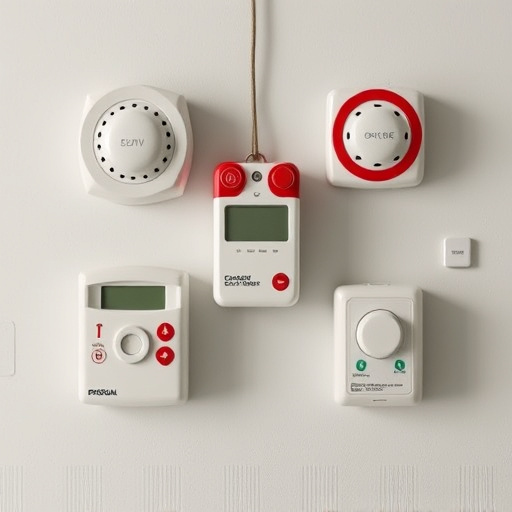Wearable Personal Alarms for Seniors enhance safety by providing quick emergency assistance through discreet buttons and advanced features like fall detection and GPS tracking. Monitoring services ensure prompt response, with real-time location data and alerts, catering to seniors' diverse needs for peace of mind and well-being management.
In today’s world, ensuring the safety of our aging population is paramount. Portable panic buttons equipped with monitoring services offer a revolutionary solution for elderly care. This article delves into the growing need for wearable personal alarms among seniors and highlights their benefits in promoting independence and peace of mind. We explore how monitoring services enhance these systems, providing 24/7 support. Additionally, we guide readers through choosing the right device and offer practical installation tips for effective senior care management.
- Understanding Wearable Personal Alarm Needs for Seniors
- Benefits of Portable Panic Buttons for Elderly Safety
- How Monitoring Services Enhance Senior Alert Systems
- Choosing the Right Wearable Alarm with Advanced Features
- Installation and Use Cases for Effective Senior Care Monitoring
Understanding Wearable Personal Alarm Needs for Seniors
Senior citizens often require additional support and safety measures, especially when living alone. This is where a Wearable Personal Alarm for Seniors becomes an invaluable tool. These portable devices are designed to provide peace of mind by offering quick and discreet access to help in case of emergencies. With just a simple press of a button, seniors can connect directly with emergency services or pre-programmed contacts, ensuring prompt response times.
Understanding the unique needs of senior citizens is crucial when selecting such a device. Wearable alarms should be comfortable, easy to use, and perhaps most importantly, reliable in various situations. Many modern models incorporate fall detection sensors, automatic alerts, and even GPS tracking, making them more than just a panic button—they become a comprehensive safety solution tailored to the specific requirements of seniors.
Benefits of Portable Panic Buttons for Elderly Safety
Portable panic buttons have emerged as a game-changer in elderly safety, offering peace of mind and enhanced security for both seniors and their loved ones. For an aging population increasingly living alone, these wearable personal alarms for seniors provide an easy and discreet way to access help in emergencies.
These devices, often attached to the wrist or worn as a pendant, allow elders to quickly signal for assistance by simply pressing the button. This is especially beneficial in situations where they might fall or experience a medical emergency and are unable to reach a phone. With a single press, a panic button can connect them to monitoring services, dispatch emergency responders, and provide vital support, ensuring timely assistance and promoting independence.
How Monitoring Services Enhance Senior Alert Systems
Monitoring services play a pivotal role in enhancing the effectiveness of senior alert systems, particularly with the rise of wearable personal alarms for seniors. These services offer real-time tracking and immediate response capabilities, ensuring that help arrives promptly when a senior needs it most. By integrating advanced technology with human oversight, monitoring centers can detect alerts, assess situations, and dispatch emergency services swiftly.
For instance, a senior wearing a portable panic button can confidently press the device in an emergency, triggering a silent alert to the monitoring service. Trained operators then verify the situation, communicate with the senior, and if necessary, coordinate with local emergency responders. This proactive approach not only provides peace of mind for seniors and their families but also helps in preventing delayed responses, especially in remote or challenging geographical locations.
Choosing the Right Wearable Alarm with Advanced Features
When selecting a portable panic button with monitoring service, it’s crucial to consider devices that offer advanced features tailored to senior citizens’ needs. Look for wearables equipped with fall detection sensors that can automatically alert emergency services if a fall is detected, ensuring swift assistance. Additionally, GPS tracking capabilities are essential for precise location sharing in case of emergencies.
Beyond basic functions, explore models featuring easy-to-read displays and simple button controls suitable for users with varying levels of dexterity. Some advanced wearables even integrate with smartphone apps, allowing seniors or their caregivers to monitor activity levels, set alerts, and remotely check in on well-being. When it comes to a wearable personal alarm for seniors, prioritizing these advanced features can significantly enhance safety and peace of mind.
Installation and Use Cases for Effective Senior Care Monitoring
The installation and utilisation of wearable personal alarms, or portable panic buttons, are pivotal in enhancing senior care monitoring. These devices can be seamlessly integrated into an elderly individual’s daily routine, often disguised as fashionable accessories like necklaces, bracelets, or even wristbands. Once activated, they instantly transmit a signal to a monitoring service centre, providing real-time location data and alerts.
Effective use cases include scenarios where seniors live alone or have mobility issues. The alarm button can be easily pressed during emergencies, such as a fall or sudden illness, ensuring prompt medical assistance. Caregivers or family members can also utilise these devices to monitor their loved ones’ activities, offering peace of mind and the ability to track their overall well-being.
A portable panic button with a monitoring service is an indispensable tool for ensuring senior safety. By understanding specific needs, leveraging advanced features, and choosing the right device, caregivers can create an effective emergency response system. These solutions not only provide peace of mind but also enhance quality of life for seniors, allowing them to maintain independence while staying connected to support when needed.
